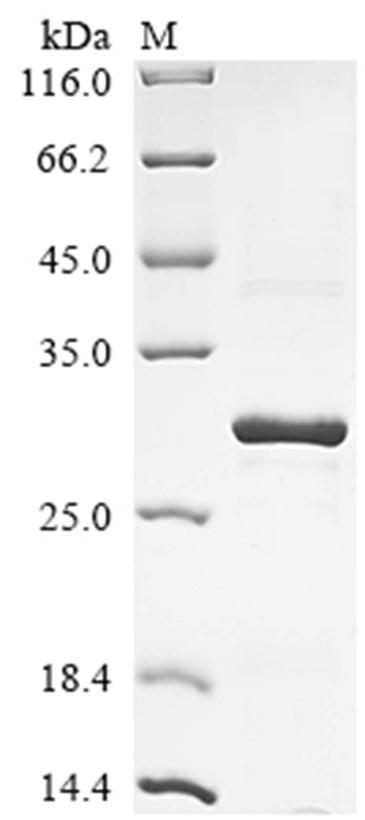Shopping Cart
Remove All Your shopping cart is currently empty
Your shopping cart is currently empty
Sortase A Protein, S. aureus, Recombinant (His) is expressed in E. coli expression system with N-6xHis tag. The predicted molecular weight is 24.9 kDa and the accession number is Q2FV99.

| Pack Size | Price | USA Warehouse | Global Warehouse | Quantity |
|---|---|---|---|---|
| 5 μg | $129 | 20 days | 20 days | |
| 10 μg | $216 | 20 days | 20 days | |
| 20 μg | $360 | 20 days | 20 days | |
| 50 μg | $543 | 20 days | 20 days | |
| 100 μg | $745 | - | In Stock | |
| 200 μg | $1,070 | 20 days | 20 days | |
| 500 μg | $1,730 | 20 days | 20 days | |
| 1 mg | $2,530 | 20 days | 20 days |
| Biological Activity | Activity has not been tested. It is theoretically active, but we cannot guarantee it. If you require protein activity, we recommend choosing the eukaryotic expression version first. |
| Description | Sortase A Protein, S. aureus, Recombinant (His) is expressed in E. coli expression system with N-6xHis tag. The predicted molecular weight is 24.9 kDa and the accession number is Q2FV99. |
| Species | Staphylococcus aureus |
| Expression System | E. coli |
| Tag | N-6xHis |
| Accession Number | Q2FV99 |
| Synonyms | Surface protein sorting A,srtA,Sortase A |
| Amino Acid | AKPHIDNYLHDKDKDEKIEQYDKNVKEQASKDKKQQAKPQIPKDKSKVAGYIEIPDADIKEPVYPGPATPEQLNRGVSFAEENESLDDQNISIAGHTFIDRPNYQFTNLKAAKKGSMVYFKVGNETRKYKMTSIRDVKPTDVGVLDEQKGKDKQLTLITCDDYNEKTGVWEKRKIFVATEVK |
| Construction | 25-206 aa |
| Protein Purity | > 85% as determined by SDS-PAGE.  |
| Molecular Weight | 24.9 kDa (predicted) |
| Endotoxin | < 1.0 EU/μg of the protein as determined by the LAL method. |
| Formulation | If the delivery form is liquid, the default storage buffer is Tris/PBS-based buffer, 5%-50% glycerol. If the delivery form is lyophilized powder, the buffer before lyophilization is Tris/PBS-based buffer, 6% Trehalose, pH 8.0. |
| Reconstitution | Reconstitute the lyophilized protein in sterile deionized water. The product concentration should not be less than 100 μg/mL. Before opening, centrifuge the tube to collect powder at the bottom. After adding the reconstitution buffer, avoid vortexing or pipetting for mixing. |
| Stability & Storage | Lyophilized powders can be stably stored for over 12 months, while liquid products can be stored for 6-12 months at -80°C. For reconstituted protein solutions, the solution can be stored at -20°C to -80°C for at least 3 months. Please avoid multiple freeze-thaw cycles and store products in aliquots. |
| Shipping | In general, Lyophilized powders are shipping with blue ice. Solutions are shipping with dry ice. |
| Research Background | Transpeptidase that anchors surface proteins to the cell wall. Recognizes and modifies its substrate by proteolytic cleavage of a C-terminal sorting signal. Following cleavage, a covalent intermediate is formed via a thioester bond between the sortase and its substrate, which is then transferred and covalently attached to the cell wall. This sortase recognizes a Leu-Pro-x-Thr-Gly (LPXTG) motif, which is cleaved by the sortase between the threonine and glycine residues. Utilizes lipid II as the peptidoglycan substrate for the sorting reaction. Responsible for the display of important virulence factors. Important for interactions with the host and host colonization during infection. |
| Size | Quantity | Unit Price | Amount | Operation |
|---|

Copyright © 2015-2026 TargetMol Chemicals Inc. All Rights Reserved.